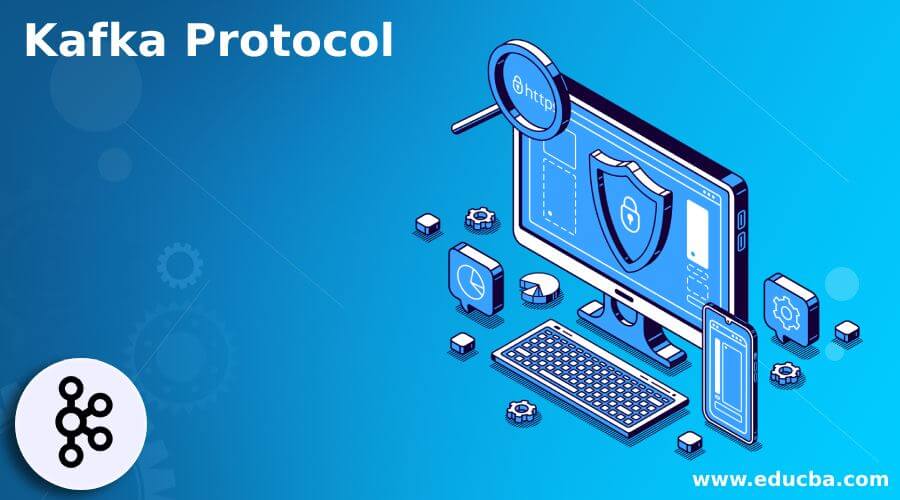Updated March 17, 2023
Introduction to Kafka Protocol
The Kafka protocol is defined as the Kafka protocol that can allow us to generate the script for observing the fitness of our Kafka implementation; we can able to pass the Kafka script in LoadRunner professional for gathering the Kafka-specific metrics that may have the producer and Kafka metrics in which producer can able to put down the event to the Kafka and consumer can able to accept the event in Kafka it means it can take event for interpretation and processing the event, the VuGen’s Kafka protocol can assists the scripting in Java with the help of standard java protocol.
Kafka Protocol HTTP
The HTTP protocol works as a bridge between the HTTP protocol and Apache Kafka, in which Apache Kafka can utilize the custom protocol. There are various client applications for different programming languages in which the libraries can clarify the development due to it can able to extract the Apache Kafka protocol on the lead so that each execution can give an easy API for transferring and accepting the messages, or it can carry out administrative operations over the cluster.
Apache Kafka can utilize the binary protocol. So the clients can able to access many programming languages, but there are various scenarios available where standard protocols such as HTTP can be more suitable; let us consider if we have an application that can be written in any programming language with no client performance than in such cases HTTP is easier to be in use so we can say that for acquiring the Apache cluster through HTTP protocol is more simple hence a single bridge can be accessed based on the lamina which can be the entry point of Kafka cluster.
Kafka Protocol Configuration
Let us see how to configure the Kafka protocol and services Kafka can utilize to outline the service data.
There are some prerequisites:
1. Before the configuration, we need to have the Query Northbound SNMP interface configuration items and modification and authorization of northbound SNMP interface configuration items.
2. We also need to have the faith certificate Kafka which is not given by eSight.
3. We have to associate with the administrator to get the certificate.
Step-by-step process of configuration:
1. As we have seen, if the Kafka server is not given by eSight, then we need to bring the faith certificate of the Kafka server to eSight.
- On the ‘O and M’ plane, from the main menu, we have to select Choose System Management, then certificate, then service certificate.
- From the navigation panel, we have to select Service Certificate Management.
- Then we have to click on the NBIFrm NotifyService-Kafka card.
- There is a Trust Certificate tab where we must bring our Trust certificate of Kafka.
- There is an Identity certificate tab we can look over to see if their identity certificate is present; if not, we have to bring that.
2. On the O&M panel from the main menu, we have to select System management, then we have to select Northbound, then the framework.
3. Then, from the navigation panel, we have to select the Interconnection management then there is an option.
4. After that, we will be on the Kafka client page and have to click on create.
5. We can now set the server and service information as provided.
6. Now check connectivity, then click on save.
Kafka Protocol Scripts
VuGen’s Kafka protocol can able to manage the scripting in Java with the help of standard naming protocol which we can say that the Kafka scripts can manage all the standard methods which are utilized in Java, and also VuGen can be able to supply Kafka functions, which are determined by the Kafka script and that functions are all from the static method of the Kafka producer and Kafka consumer classes which should be divided for every user, as we know Kafka is a disperse system which can have the servers and client. They can communicate with each other using a high-performance TCP network protocol.
1. The Kafka script can able to record
We can record the script in VuGen to observe the fitness of our Kafka implementation.
- First, we must ensure that the Java environment needs are set up.
- Within the VuGen new protocol, the script can generate, and the template of the Kafka script can be opened in the VuGen editor.
- There is also a need to have a configuration file for describing the properties of the consumer.
- We have to select the producer code configuration through Kafka and then the code generation node.
- We have to click the enable button to insert a consumer at the end of that script through Kafka, then in code generation.
- We can find the Record button to click for recording.
2. Kafka script can able to generate and edit manually
- We can generate or edit the Kafka script using the Kafka editor; we must ensure our Java environment is set up.
- So, we are using the VuGen and then opening the Kafka script.
- Then we have to put the java code into the script within the applicable method, and while generating the script, we have to divide the producer and consumer; with the help of VuGen’s Kafka API, we can also be able to divide the producer and Kafka into the ‘init’ method and that can be concluded in an end method.
Conclusion
In this article, we conclude that it manages the topics more or less of the lamina, and Kafka can utilize the binary protocol over TCP; we have also seen the HTTP, Kafka protocol configuration, and the scripts, which can be helpful to us.
Recommended Articles
This is a guide to Kafka Protocol. Here we discuss the introduction, Kafka protocol HTTP & configuration, and scripts. You may also have a look at the following articles to learn more –


